 Technology peripherals
Technology peripherals
 AI
AI
 Learn to assemble a circuit board in 20 minutes! The open source SERL framework has a 100% precision control success rate and is three times faster than humans
Learn to assemble a circuit board in 20 minutes! The open source SERL framework has a 100% precision control success rate and is three times faster than humans
Learn to assemble a circuit board in 20 minutes! The open source SERL framework has a 100% precision control success rate and is three times faster than humans
Now, robots can learn precise factory control tasks.
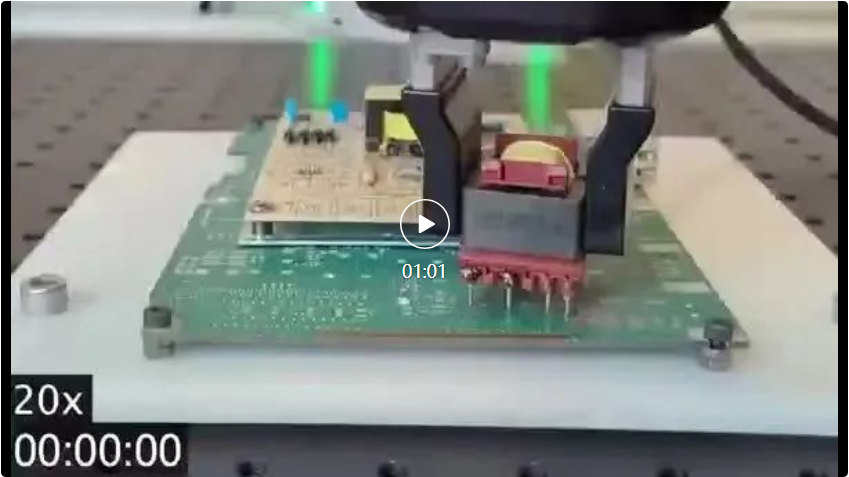 #In recent years, significant progress has been made in the field of robotic reinforcement learning technology, such as quadruped walking, grasping, dexterity Control, etc., but most of them are limited to the laboratory demonstration stage. Widely applying robot reinforcement learning technology to actual production environments still faces many challenges, which to a certain extent limits its application scope in real scenarios. In the process of practical application of reinforcement learning technology, it is necessary to overcome multiple complex problems including reward mechanism setting, environment reset, sample efficiency improvement, and action safety guarantee. Industry experts emphasize that solving the many problems in the actual implementation of reinforcement learning technology is as important as the continuous innovation of the algorithm itself.
#In recent years, significant progress has been made in the field of robotic reinforcement learning technology, such as quadruped walking, grasping, dexterity Control, etc., but most of them are limited to the laboratory demonstration stage. Widely applying robot reinforcement learning technology to actual production environments still faces many challenges, which to a certain extent limits its application scope in real scenarios. In the process of practical application of reinforcement learning technology, it is necessary to overcome multiple complex problems including reward mechanism setting, environment reset, sample efficiency improvement, and action safety guarantee. Industry experts emphasize that solving the many problems in the actual implementation of reinforcement learning technology is as important as the continuous innovation of the algorithm itself. 
Project homepage: https://serl-robot.github.io/ Open source code: https://github.com/rail-berkeley /serl - ##Thesis title: SERL: A Software Suite for Sample-Efficient Robotic Reinforcement Learning
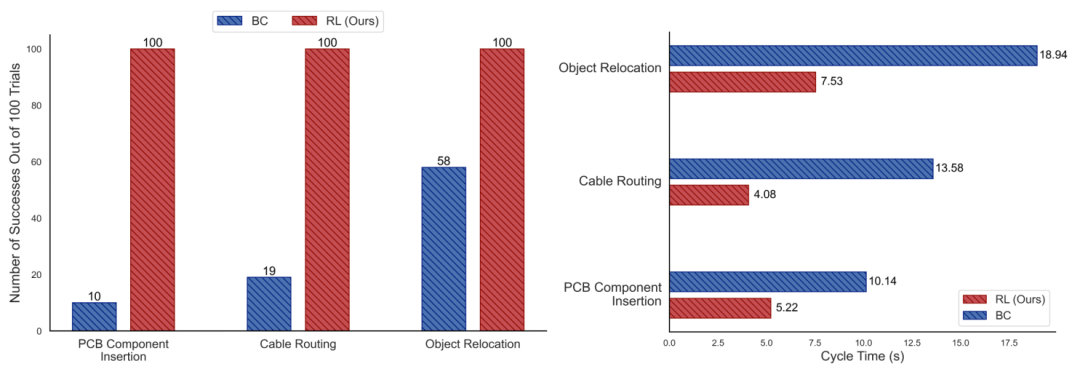 Figures 1 and 2: Comparison of success rate and number of beats between SERL and behavioral cloning methods in various tasks. With a similar amount of data, the success rate of SERL is several times higher (up to 10 times) than that of clones, and the beat rate is at least twice as fast.
Figures 1 and 2: Comparison of success rate and number of beats between SERL and behavioral cloning methods in various tasks. With a similar amount of data, the success rate of SERL is several times higher (up to 10 times) than that of clones, and the beat rate is at least twice as fast.

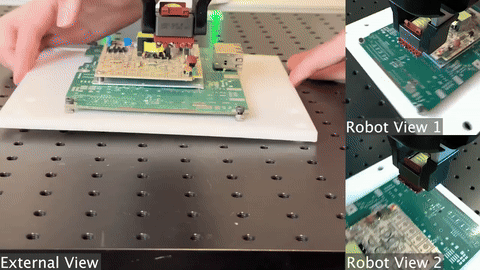
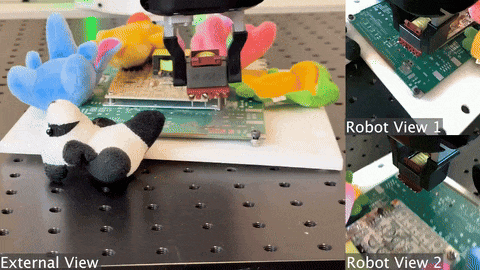
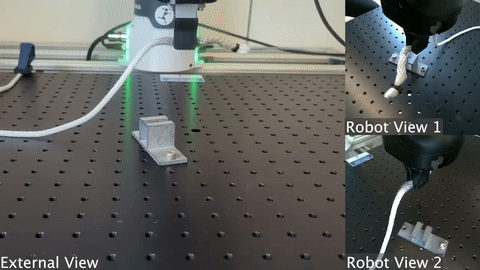
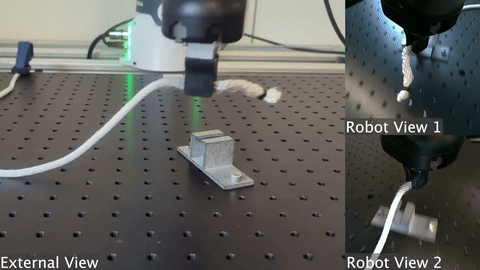
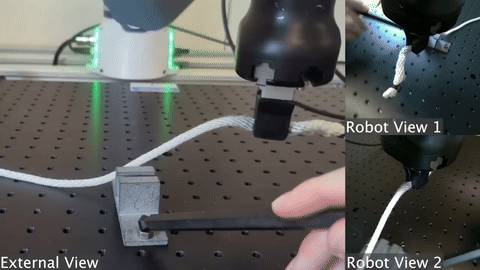

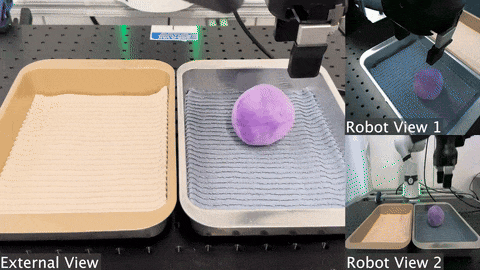

##He was born in 1991 in Munich Technik The university earns PhDs in mechanical engineering and artificial intelligence. He is a postdoctoral researcher in the Department of Brain and Cognitive Sciences and the Artificial Intelligence Laboratory at MIT, an invited researcher at the ATR Human Information Processing Research Laboratory in Japan, and an adjunct assistant professor in the Department of Kinesiology at Georgia Institute of Technology and Pennsylvania State University in the United States. . He also served as leader of the computational learning group during the Japanese ERATO project, the Jawa Kinetic Brain Project (ERATO/JST). In 1997, he became a professor of computer science, neuroscience, and biomedical engineering at USC and was promoted to tenured professor. His research interests include topics such as statistics and machine learning, neural networks and artificial intelligence, computational neuroscience, functional brain imaging, nonlinear dynamics, nonlinear control theory, robotics, and biomimetic robots.
He was one of the founding directors of the Max Planck Institute for Intelligent Systems in Germany, where he led the Autonomous Motion Department for many years. He is currently chief scientist at Intrinsic, Alphabet's [Google] new robotics subsidiary. Stefan Schaal is an IEEE Fellow.
She is a computer science and electrical engineering major at Stanford University assistant professor. Her lab, IRIS, research explores intelligence through large-scale robot interaction and is part of SAIL and the ML Group. She is also a member of the Google Brain team. She is interested in the ability of robots and other intelligent agents to develop a wide range of intelligent behaviors through learning and interaction. She previously completed a PhD in computer science from the University of California, Berkeley, and a bachelor's degree in electrical engineering and computer science from the Massachusetts Institute of Technology.
He is Paul G. Allen of the University of Washington Assistant Professor in the School of Computer Science and Engineering, leading the WEIRD Laboratory. Previously, he was a postdoctoral scholar at MIT, working with Russ Tedrake and Pulkit Agarwal. He completed his PhD on machine learning and robotics at BAIR, UC Berkeley, under the supervision of Professors Sergey Levine and Pieter Abbeel. Prior to that, he also completed his bachelor's degree at the University of California, Berkeley. His main research goal is to develop algorithms that enable robotic systems to learn to perform complex tasks in a variety of unstructured environments, such as offices and homes.
The above is the detailed content of Learn to assemble a circuit board in 20 minutes! The open source SERL framework has a 100% precision control success rate and is three times faster than humans. For more information, please follow other related articles on the PHP Chinese website!

Hot AI Tools

Undresser.AI Undress
AI-powered app for creating realistic nude photos

AI Clothes Remover
Online AI tool for removing clothes from photos.

Undress AI Tool
Undress images for free

Clothoff.io
AI clothes remover

AI Hentai Generator
Generate AI Hentai for free.

Hot Article

Hot Tools

Notepad++7.3.1
Easy-to-use and free code editor

SublimeText3 Chinese version
Chinese version, very easy to use

Zend Studio 13.0.1
Powerful PHP integrated development environment

Dreamweaver CS6
Visual web development tools

SublimeText3 Mac version
God-level code editing software (SublimeText3)

Hot Topics
 1378
1378
 52
52
 DeepMind robot plays table tennis, and its forehand and backhand slip into the air, completely defeating human beginners
Aug 09, 2024 pm 04:01 PM
DeepMind robot plays table tennis, and its forehand and backhand slip into the air, completely defeating human beginners
Aug 09, 2024 pm 04:01 PM
But maybe he can’t defeat the old man in the park? The Paris Olympic Games are in full swing, and table tennis has attracted much attention. At the same time, robots have also made new breakthroughs in playing table tennis. Just now, DeepMind proposed the first learning robot agent that can reach the level of human amateur players in competitive table tennis. Paper address: https://arxiv.org/pdf/2408.03906 How good is the DeepMind robot at playing table tennis? Probably on par with human amateur players: both forehand and backhand: the opponent uses a variety of playing styles, and the robot can also withstand: receiving serves with different spins: However, the intensity of the game does not seem to be as intense as the old man in the park. For robots, table tennis
 The first mechanical claw! Yuanluobao appeared at the 2024 World Robot Conference and released the first chess robot that can enter the home
Aug 21, 2024 pm 07:33 PM
The first mechanical claw! Yuanluobao appeared at the 2024 World Robot Conference and released the first chess robot that can enter the home
Aug 21, 2024 pm 07:33 PM
On August 21, the 2024 World Robot Conference was grandly held in Beijing. SenseTime's home robot brand "Yuanluobot SenseRobot" has unveiled its entire family of products, and recently released the Yuanluobot AI chess-playing robot - Chess Professional Edition (hereinafter referred to as "Yuanluobot SenseRobot"), becoming the world's first A chess robot for the home. As the third chess-playing robot product of Yuanluobo, the new Guoxiang robot has undergone a large number of special technical upgrades and innovations in AI and engineering machinery. For the first time, it has realized the ability to pick up three-dimensional chess pieces through mechanical claws on a home robot, and perform human-machine Functions such as chess playing, everyone playing chess, notation review, etc.
 Claude has become lazy too! Netizen: Learn to give yourself a holiday
Sep 02, 2024 pm 01:56 PM
Claude has become lazy too! Netizen: Learn to give yourself a holiday
Sep 02, 2024 pm 01:56 PM
The start of school is about to begin, and it’s not just the students who are about to start the new semester who should take care of themselves, but also the large AI models. Some time ago, Reddit was filled with netizens complaining that Claude was getting lazy. "Its level has dropped a lot, it often pauses, and even the output becomes very short. In the first week of release, it could translate a full 4-page document at once, but now it can't even output half a page!" https:// www.reddit.com/r/ClaudeAI/comments/1by8rw8/something_just_feels_wrong_with_claude_in_the/ in a post titled "Totally disappointed with Claude", full of
 At the World Robot Conference, this domestic robot carrying 'the hope of future elderly care' was surrounded
Aug 22, 2024 pm 10:35 PM
At the World Robot Conference, this domestic robot carrying 'the hope of future elderly care' was surrounded
Aug 22, 2024 pm 10:35 PM
At the World Robot Conference being held in Beijing, the display of humanoid robots has become the absolute focus of the scene. At the Stardust Intelligent booth, the AI robot assistant S1 performed three major performances of dulcimer, martial arts, and calligraphy in one exhibition area, capable of both literary and martial arts. , attracted a large number of professional audiences and media. The elegant playing on the elastic strings allows the S1 to demonstrate fine operation and absolute control with speed, strength and precision. CCTV News conducted a special report on the imitation learning and intelligent control behind "Calligraphy". Company founder Lai Jie explained that behind the silky movements, the hardware side pursues the best force control and the most human-like body indicators (speed, load) etc.), but on the AI side, the real movement data of people is collected, allowing the robot to become stronger when it encounters a strong situation and learn to evolve quickly. And agile
 ACL 2024 Awards Announced: One of the Best Papers on Oracle Deciphering by HuaTech, GloVe Time Test Award
Aug 15, 2024 pm 04:37 PM
ACL 2024 Awards Announced: One of the Best Papers on Oracle Deciphering by HuaTech, GloVe Time Test Award
Aug 15, 2024 pm 04:37 PM
At this ACL conference, contributors have gained a lot. The six-day ACL2024 is being held in Bangkok, Thailand. ACL is the top international conference in the field of computational linguistics and natural language processing. It is organized by the International Association for Computational Linguistics and is held annually. ACL has always ranked first in academic influence in the field of NLP, and it is also a CCF-A recommended conference. This year's ACL conference is the 62nd and has received more than 400 cutting-edge works in the field of NLP. Yesterday afternoon, the conference announced the best paper and other awards. This time, there are 7 Best Paper Awards (two unpublished), 1 Best Theme Paper Award, and 35 Outstanding Paper Awards. The conference also awarded 3 Resource Paper Awards (ResourceAward) and Social Impact Award (
 Hongmeng Smart Travel S9 and full-scenario new product launch conference, a number of blockbuster new products were released together
Aug 08, 2024 am 07:02 AM
Hongmeng Smart Travel S9 and full-scenario new product launch conference, a number of blockbuster new products were released together
Aug 08, 2024 am 07:02 AM
This afternoon, Hongmeng Zhixing officially welcomed new brands and new cars. On August 6, Huawei held the Hongmeng Smart Xingxing S9 and Huawei full-scenario new product launch conference, bringing the panoramic smart flagship sedan Xiangjie S9, the new M7Pro and Huawei novaFlip, MatePad Pro 12.2 inches, the new MatePad Air, Huawei Bisheng With many new all-scenario smart products including the laser printer X1 series, FreeBuds6i, WATCHFIT3 and smart screen S5Pro, from smart travel, smart office to smart wear, Huawei continues to build a full-scenario smart ecosystem to bring consumers a smart experience of the Internet of Everything. Hongmeng Zhixing: In-depth empowerment to promote the upgrading of the smart car industry Huawei joins hands with Chinese automotive industry partners to provide
 Li Feifei's team proposed ReKep to give robots spatial intelligence and integrate GPT-4o
Sep 03, 2024 pm 05:18 PM
Li Feifei's team proposed ReKep to give robots spatial intelligence and integrate GPT-4o
Sep 03, 2024 pm 05:18 PM
Deep integration of vision and robot learning. When two robot hands work together smoothly to fold clothes, pour tea, and pack shoes, coupled with the 1X humanoid robot NEO that has been making headlines recently, you may have a feeling: we seem to be entering the age of robots. In fact, these silky movements are the product of advanced robotic technology + exquisite frame design + multi-modal large models. We know that useful robots often require complex and exquisite interactions with the environment, and the environment can be represented as constraints in the spatial and temporal domains. For example, if you want a robot to pour tea, the robot first needs to grasp the handle of the teapot and keep it upright without spilling the tea, then move it smoothly until the mouth of the pot is aligned with the mouth of the cup, and then tilt the teapot at a certain angle. . this
 Distributed Artificial Intelligence Conference DAI 2024 Call for Papers: Agent Day, Richard Sutton, the father of reinforcement learning, will attend! Yan Shuicheng, Sergey Levine and DeepMind scientists will give keynote speeches
Aug 22, 2024 pm 08:02 PM
Distributed Artificial Intelligence Conference DAI 2024 Call for Papers: Agent Day, Richard Sutton, the father of reinforcement learning, will attend! Yan Shuicheng, Sergey Levine and DeepMind scientists will give keynote speeches
Aug 22, 2024 pm 08:02 PM
Conference Introduction With the rapid development of science and technology, artificial intelligence has become an important force in promoting social progress. In this era, we are fortunate to witness and participate in the innovation and application of Distributed Artificial Intelligence (DAI). Distributed artificial intelligence is an important branch of the field of artificial intelligence, which has attracted more and more attention in recent years. Agents based on large language models (LLM) have suddenly emerged. By combining the powerful language understanding and generation capabilities of large models, they have shown great potential in natural language interaction, knowledge reasoning, task planning, etc. AIAgent is taking over the big language model and has become a hot topic in the current AI circle. Au



